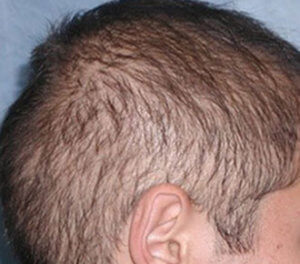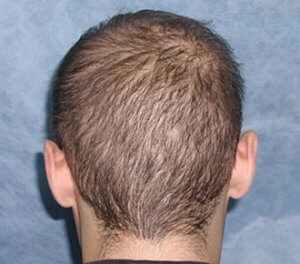

A 25-year-old male presents with gradual thinning since age 16. He has used minoxidil consistently for 10 years with minimal improvement. He denies symptoms of itching, tenderness, or tingling. His scalp appears normal on physical exam.
- What is the most likely diagnosis?
- Male pattern alopecia
- Post-chemo effluvium
- Diffuse alopecia areata
- Diffuse Un-Patterned Alopecia (DUPA)
- Lichen Plano-pilaris (LPP)
- What would be the next best step to determine the cause of this patient’s hair loss?
- Scalp biopsy
- Dermoscopy
- Scalp scraping
- Hair-pull
- Bloodwork for androgens
- What would be the initial recommended treatment for this patient?
- Finasteride and minoxidil
- Low dose systemic steroids
- Oral antifungals
- Laser cap
- PRP
Answers:
1) d. Diffuse thinning that starts at an early age and involves the entire scalp is most consistent with Diffuse Un-Patterned Alopecia (DUPA). In another condition called Diffuse Patterned Alopecia (DPA), the top of the scalp thins uniformly, but the back and sides of the scalp are spared. DUPA and DPA stand in contrast to the more common Norwood pattern of balding where the corners of the scalp deepen and the crown thins, gradually coalescing over time. Despite the wide variety in clinical presentations, these conditions are all variations of androgenetic alopecia and a family history is generally positive for extensive hair loss.
2) b. Examination of this patient’s scalp with dermoscopy will reveal extensive miniaturization, not only across the top of his head, but also at the back and sides. Miniaturization occurs when there is genetic sensitivity of the follicles to the hormone dihydrotestosterone (DHT) that cause progressive thinning and shortening of the hair shaft. Importantly, it is a focal process, that begins with some follicles and not others. Over time, more follicles become involved. This differs from thinning hair that occurs with age (senile alopecia). In these two conditions, the follicles are thin, but of uniform diameter.
A scalp biopsy can be confirmatory, but this is a diagnosis that can be made clinically using densitometry. A hair-pull is negative and androgen levels are usually normal.
3) a. The best treatment for men with DUPA is oral finasteride, which will block the formation of DHT so that hairs do not progressively miniaturize. Minoxidil can add additional benefit. It is also important to know that these patients are not good candidates for hair transplant, as the donor zone for transplanted hair at the back and sides is not stable.
Comment: The patient described above is a case of “Classic” DUPA with rapid generalized thinning that begins in the teenage years. There is also an adult form of DUPA that starts at an older age, is less progressive, but is far easier to slide under one’s diagnostic radar. It is this condition that is often treated inappropriately with surgery. In all cases, patients with DUPA will benefit greatly from early diagnosis and treatment with medical therapy that includes finasteride.
If you are experiencing gradual hair thinning, please contact our office for an appointment. Call 212-826-2400 or schedule a consult here.






